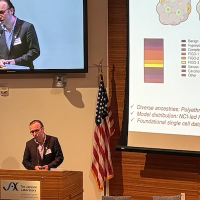International Medical Conference Endometriosis 2025:
Endometriosis 2025: Your Mother Should Know, Your Doctor Should Know Better!
Bladder Endometriosis- Wide Range of Difficulty - Ted Lee, MD
Good afternoon everybody. Sorry I'm not there in person this year as I'm traveling. But I want to thank Dr. Tim Kin and Dr. Dan Martin for inviting me to present at this popular conference. My topic is on bladder endometriosis wide range of difficulty. How does location and size impact management? So the definition of bladder endometriosis is endometriosis infiltrating detrusor muscle. So I'm not talking about endometriosis on the bladder perineum, I'm talking about endometriosis that's deep infiltrating through the muscle of the bladder. In terms of clinical features, the pathophysiology of bladder endometriosis is very similar to any other deep infiltrating endometriosis, although it can be atrogenic from previous C-section, it rarely occurs in isolation, so it frequently coexists with severe rectal vaginal endometriosis. Requiring biosurgery exception to this rule is endometriosis associated with C-section and the symptoms of bladder endometriosis dysuria, frequently cyclic as well as hematuria.
And at times patient may not be symptomatic. In terms of treatment, it's fairly straightforward, especially if it's near abdominal bladder used to a simple partial cystectomy with a two layer closure. If the nodule is close to the uteral office that we would recommend neutral stent just to protect the ureter from harm. If the mitosis near the vesco vaginal space, we typically would develop the Vesco vaginal space and mobilize the bladder completely to allow for tension free closure and for large defect opening retro pubic space which also take attention off the repair as well. And if you're not saying about the proximity of the bladder mitosis to the uretal office, it is prudent to do a preoperative cystoscopy before surgery so that you will know whether there would be a need for uretal replant or not. In terms of surgical treatment, if nodule is close to uteral office, intravesical portion of the uterine may be involved and you may have to do implantations, especially patient, have no hydronephrosis.
If the nodule is very big, consider gage agonist for three months to minimize the loss of bladder capacity to shrink the size of the nodule so you don't have to remove as much bladder. After you finish repair, you do black field the bladder to make sure you have watertight closure and leave the catheter in place for seven to 10 days and followed by avoiding urethrogram to ensure the integrity of your repair. The following are pictures of bladder endometriosis. As you can see here is a single nodule on the thermal bladder, very small, about 1.5 centimeter in size. You can see on the cross-sectional view as well. It's a little bit off to the left side of the bladder. This are very simple, you just remove it and close the cystotomy in two layers. In this case the nodule is bigger, way bigger and it's near the al bladder.
A little bit off to the left side as well on the coronal view. This just give you some idea of what this will look like in this particular patient. This patient has a very large five centimeter nodules involving the intravascular portion of the ureter. Patient has also have non hydronephrosis as well. In this patient you can see that this is at the bottom near the trigone of the bladder as involving the ureter here all. So in this case it's pretty obvious but a lot of cases it's not so obvious because it could be just partially involved. But in this case, because the size of nodule is so big that it's pretty obvious it's involving the ureter. And plus we know that she hydronephrosis and at times patient may have other concurrent GI pathology and most people will be focusing on all the multiple fibroids that this patient has.
So the fibroid can be very distracting to the radiologist that read this MRI. But if you are astute and if you pay attention to patient's symptoms that you'll notice that this patient has osis and a lot of times people would just attribute the patient's urinate frequency urgency to the fibroid uterus and not to the bloodline endometriosis. So you can see that the compression here, the in notation that he makes on the bladder wall, and you can see that here it is on the central sections. You can see the bladder endometriosis right over here. Now as I mentioned before, many of the patients with blood endometriosis also have rectal signal endometriosis. You can see the mushrooms caps sign with the concurrent endometriosis involving the rectum as well as to the bladder. These are very, very good images of this problem the patient may have. So a lot of times bladder mitosis, as I mentioned before, does not occur in isolation.
Frequently the same pathophysiologies that cause to be rated endometriosis on the bladder would also cause to be rated mitosis of the bladder of the rectum. And here is the cystoscopy view of the bladder. Endometriosis will put a stent in place in a lot of this patient who have endometriosis in the bladder just to make sure that we don't incorporate the ureter into our repair. And you can see the nodule, you can see this pretty obvious nodule here. And this is the typical video of patient with bladder endometriosis. And the following is a couple example of resection of bladder endometriosis. This patient's nodule is very close to the vascular vaginal region. So after the nodule I usually score the circumference of the nodule with a multiple energy just to get a sense of where circumscribe the lesions, just get a sense of where the nodule would be just so we mark.
And then I'll follow up with devices like in seal or can use it OID scalpel to using a squeeze technique to basically bounce off the nodule so that you would remove the nodule intact completely without leaving disease behind. So frequently if you just use multiple energy, there are times you would actually cut through the nodule and there being piece of a nodule behind. And this is mostly just to score it to circumscribe it before I would begin to use the squeeze technique to inate the rest of the nodule. And this is a very old video, but I think because of the location of this nodule I think will be give you a very good sense of what would be required to repair and remove a nodule like this. So this would be very, very close to the C-section scar. Now I'm using the squeeze technique to bounce off the nodule and devices that can seal on my scalpel.
When you bounce it off, it doesn't like to go through a nodule per se. So when we bounce it off, you'll be able to remove the entire nodules fairly completely essentially. Whereas if you use monoclonal energy, you risk of cutting through the nodule, I mean the lumen of the bladder at this point and then basically bounce it off the nodule. And you can see that this is attached to the loran segment as well. So this possibility that this patient may have this develop as a result of C-sections. And I put a stand in place just so that we know exactly where the nodule is in relationship to the ure at the course of the ureter and a lot of traction and contact traction involve. And I'm trying to remove as little bladder as possible to ensure that the patient has enough capacity. And that's always the goal is just remove just enough.
But at the same time, we don't want to leave disease behind again using the squeeze technique that allow me to cut through the softer tissues and maximize the amount of the bladder preserve in any of this resection for blind endometriosis. So this will be kind of the end of the excision of this nodule patient also has a small nodule off to right side of the on the corner there and up opening the vesco vaginal space to build vesco vaginal space so the bladder can be cut close without tension. You can see this is a residual nodule right here, which I'm going to go go ahead and excise. It's involving the loran segment here as well as I cut through it, you'll notice some brown stuff coming out of here. Okay, this is actually going directly into the loran segment at this point. And now I'm in the right tissue plan here. And then I basically, once I get the right tissue plan, I can cle the rest of the nodule of the uterus and of the bladder. And once everything the margin has been created, we will excise the rest of the nodule of the corner.
So this patient had the multifocal disease that was cvu squeeze technique, just a good idea where I should cut. So with a squeeze technique that you'll never leave disease behind because simply that you cannot cut through a nodule because you're bouncing off the nodule filling for the margin. Where I should cut. And this is additional, this is a patient with multifocal bladder endometriosis, a smaller nodule that's remove and the rest of it are suturing and also mobilizing the bladder of the vagina. That's a bright skin n tear retractor in the anterior Forex. And then once bladder is completely mobilized, we can close that in two layers without tension at all.
And this is very, very important is that to allow, develop the proper tissue plane so that the bladder can be closed easily. And this is be closed in two layers. And typically I use the three zero vlock suture for all my bladder, all my rectal defect that I created from excision of endometriosis. And we're the first people to publish the use of barb suture for bladder and the bowel closure repair after excision of endometriosis. So basically the rest of it's going to look like a vaginal cuff closure essentially. Very straightforward. And we'll just do this in a running suture in two layers. The first layer is basically full thickness muscularis and then mucosa. And the second layer is basically an implicating layer to reinforce the first layer. So I'm going to just go ahead and speed things through and then this is the end of first layer and then we'll close that up and then we'll do an implicating layer after this is a second layer so that it's important to mobilize the bladder of the vagina. Otherwise you won't be able to apply this second layer of closure in this situation where theosis very, very close to the vagina and that's the second layer. And then that's really the closure. And then you basically backfield the bladder with water and then make sure you have watertight closure, then you're all set.
And we'll cut both sutures. And that's the example of bladder and mitro resection. And this is the blast video. This is a patient with a large nodule involving basically her uteral office on the left side. The nodule has basically invaded towards the anterior vagina and into the obria tennis muscle. From the outside it doesn't look like much, you don't see the endometriosis, but everything is retroperitoneal. This is the hydro ureter that is completely obstructed. She still has good function of the kidney on the side, so we trying to rebuild the ureter uterine artery. The para vesical space is being completely, the per recal space is completely obliterated and that's the hydro ureter currently isolate rine artery in its origin because the rine artery is completely scar. So we basically temporarily clip the internal eli artery to minimize bleeding during the dissections. Normally I'll clip the uterine artery, but in this case, because uterine artery is obliterated by theosis, we open the bladder through the peri vesical space.
And you can see the nodule has infiltrated and you can see the 40 catheter. The nodule is bigger than the 40 bulb. The ureter is completely distended and dilated and it's basically obstructed where the uterine artery crosses over. So we translate the ureter, you can see the urine stream coming out of the ureter. The nodules keep on going and now you can see the tenderness muscles. So basically this has invaded and we cannot complete the resection because the fold catheter is in the way. And the control lateral uter office is next to our resection. So we had to protect the contr lateral ureter as well. This area is completely fibrotic and this is basically extended towards to the cul spine posteriorly. And it's basically like rock. I mean this is a very, very big size nodule. And then we cut it off its base near the ischial spine.
And now we basically uprooted this nodule of the posterior bladder and we put the bright skin refrigerator in the vagina to mobilize the bladder more so that allow us to close the bladder. And we basically have to open the retro pubic space completely. So that will allow us to have a tension free repair. And then we transact the, that's the acus and that's the ureter that we are trying to reimplant completely mobilize the ureter. Well first of all, we have to close the bladder first in two layers because the location of the cystotomy is very low and posterior that the ureter will not be able to reach. So it causes in two layers with a running bob suture three L bob suture with dis standard bladder with the water. And we basically completely mobilize the bladder of the anterior vaginal wall by completely open the retro pubic space. And we're trying to see if we can reach, we still needs a bit more mobility, so we completely mobilize the bladder completely off and that's ligament and that's the right ureter.
And now we can reach the bladder. And so we open cystotomy and we speculate the ureter. So then we can implant the ureter. I usually use a four zero PDS to run it on one side and to the other. And this is just inco knot time. We basically do one side of the closure of the implantation and the other side, we'll put a double J stent in right now, put double J stent in and stuff inside the bladder. And then we'll close the yellow side of the implantations with again running suture of four zero PDS.
And then we will go ahead and close the rest of the implantations. We running suture of four zero PDS and the handle we use will excise that piece of a ureter we use to handle the ureter and will cause the rest of cystotomy with the same running suture of four zero PDS. We'll back fill the bladder, make sure we have air tight closure, and then we'll implicate the ureter to prevent reflux. And you can do that with bob sutures. So basically sandwich the ureter almost like a hot dog in a bun and we'll envelop the ureter within this I implicating stitch to minimize reflux. And that's the repair for this patient with large nodule bladder nodule involvement, the ureter, and that's the final B. So in terms of prognosis, after partial cystectomy for deep bladder endometriosis, the recurrence rate is very low for thumb endometriosis. For a bladder based endometriosis that I show that involving the trigon, the recurrence rate is much, much higher. It's over 30%, 37%, and you can see why, because it require a lot more complicated surgery. So definitely another location of your bladder nodule. Make sure it's not involving the ureter or not near the ureter office. Thank you for your attention.










